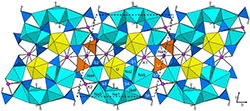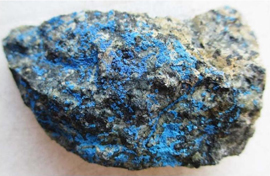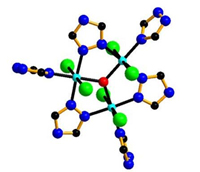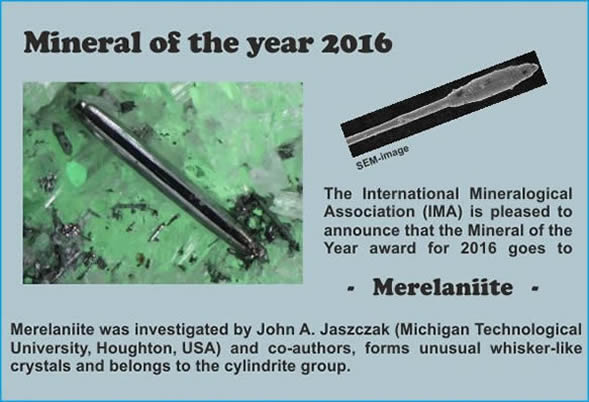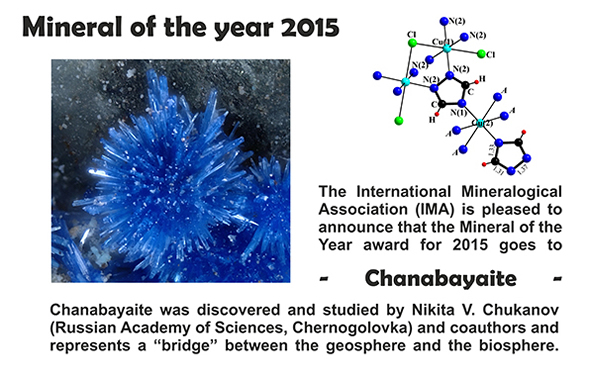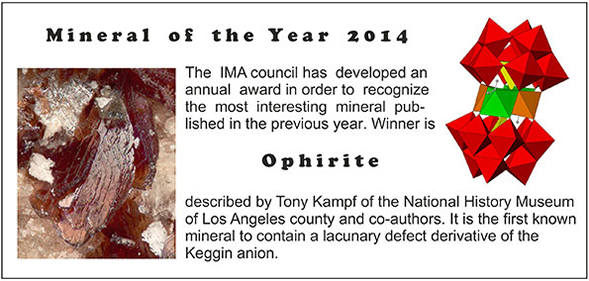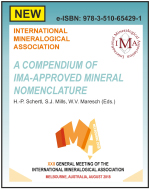Home page > MINERAL OF THE YEAR
MINERAL OF THE YEAR
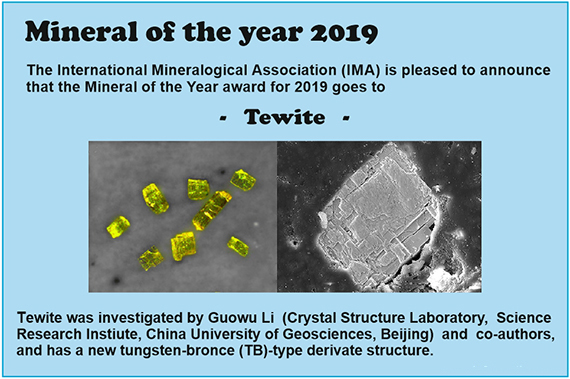
In 2014, the IMA introduced its “Mineral of the Year” initiative, aimed to recognize the most inspiring and exciting mineral discoveries published in a given calendar year. With this initiative, the IMA likes also to acknowledge the Commission on New Minerals, Nomenclature and Classification (CNMNC) for their tireless work. It is never easy choosing the winner and we are happy to announce the finalists in the category “Mineral of the Year 2019”:
The prestigious title went to “Tewite” that was discovered in the vicinity of Nanyang village, Huaping County, located in the south of the Panzhihua–Xichang region, southwestern China. It occurs in the Neoproterozoic Sinian light-weathered biotite–quartz monzonite, near the contact zone with gabbro. The associated minerals are alkali feldspar, biotite, clinoamphibole, ilmenite, zircon, zoisite, tourmaline, monazite-(Ce), allanite-(Ce), scheelite, tellurite and the new mineral wumuite (KAl0.33W2.67O9, IMA2017-067a), in addition to an unidentified, potentially new mineral corresponding to WO3.
Tewite forms platy crystals that range from 0.08×0.1×0.1 to 0.1×0.2×0.5 mm in size. The crystals are greenish yellow, with a light-yellow to white streak, translucent to transparent, and with adamantine luster. Mohs hardness is 3½–4, and the tenacity is brittle. Tewite has perfect {100}, {001}, and {010} cleavages. The empirical formula, based on 19 O, is (K1.61Na0.06□0.33)∑2.00(Te1.06W0.35□0.59)∑2.00W5O19. Already first studies showed tewite to be a new mineral with a new crystal-structure type and a composition containing Te, W and K. No similar minerals or synthetic compounds corresponding to this mineral have been previously found.
Tewite has a new tungsten-bronze (TB)-type derivative structure. Distorted TeO6 octahedra break TB slabs into ribbons which are displaced by ½ a relative to their neighbors, while K partly occupies two mutually exclusive sites in hexagonal channels || c. Short-range order and displacement of K ions are likely responsible for an observed incommensurate modulation of the average structure indicated by weak satellite reflections along c*, which were not considered in the structure refinement.
The two closest runners-up were Rudabanyaite, a new mineral with a [Ag2Hg2]4+ cluster cation from the Rudabánya ore deposit (Hungary) described by Herta Effenberger and co-authors (2019) in the European Journal of Mineralogy and Davidbrownite-(NH4), a new phosphate–oxalate mineral from the Rowley mine, Arizona, USA, described by Anthony R. Kampf and co-authors in the Mineralogical Magazine (2019).
REFERENCES
Li, Guowu, Xue, Yuan, Xiong, Ming (2019): Tewite: A K–Te–W new mineral species with a modified tungsten-bronze type structure, from the Panzhihua-Xichang region, southwest China. European Journal of Mineralogy 31 (1):145–152.
https://doi.org/10.1127/ejm/2019/0031-2813
Effenberger, H., Szakáll, S., Fehér, B., Váczi, T.; Zajzon, N. (2019): Rudabányaite, a new mineral with a [Ag2Hg2]4+ cluster cation from the Rudabánya ore deposit (Hungary).
European Journal of Mineralogy 31 (3):537–547.
https://doi.org/10.1127/ejm/2019/0031-2830
Kampf, A.R., Cooper, M.A., Rossman, G.R., Nash, B.P., Hawthorne, F.C., Marty, J. (2019): Davidbrownite-(NH4), (NH4,K)5(V4+O)2(C2O4)[PO2.75(OH)1.25]4·3H2O, a new phosphate–oxalate mineral from the Rowley mine, Arizona, USA. Mineralogical Magazine 83 (6):869-877.
https://doi.org/10.1180/mgm.2019.56
MINERAL OF THE YEAR 2018
At long last and after much deliberation, the IMA Commission on New Minerals, Nomenclature and Classification is pleased to announce its chosen Mineral of the Year 2018. The “race” was tight and there were many worthy contenders, but the winner is a true gem (or at least, was presented as such in the media). The new complex oxide carmeltazite (ZrAl2Ti4O11) forms black inclusions in blue corundum crystals (“Carmel SapphireTM”) from Cretaceous pyroclastic rocks and associated alluvial deposits at Kishon Mid-Reach in northern Israel. Its name alludes to the type locality at Mt. Carmel and the three principal metals in its formula (Ti, Al and Zr). Carmeltazite was discovered by William L. Griffin (Macquarie University, Australia), Sarah E.M. Gain (University of Western Australia), Luca Bindi (Università degli Studi di Firenze, Italy), Vered Toledo (Shefa Gems Ltd., Israel), Fernando Cámara (Università degli Studi di Milano, Italy), Martin Saunders (University of Western Australia), and Suzanne Y. O’Reilly (Macquarie University). Since its description was published in Minerals (Griffin et al., 2018), the mineral has gained much publicity online as “the world’s newest gemstone” (EraGem, 2019), and even an “extraterrestrial mineral harder than diamonds” (Flatley, 2019). Although perfectly terrestrial in origin and not particularly gemmy, the Mineral of the Year 2018 does contain Ti3+, altogether rare in the geological environment, and possesses a peculiar crystal structure, which is remotely related to the close-packed arrangement of spinel. As can be seen from its formula, the structure of carmeltazite is cation- and anion-deficient relative to spinels, while its symmetry is reduced to orthorhombic. Perhaps even more remarkable than its public image or structure is the association of carmeltazite with other Ti3+ and carbide minerals, which indicates very unusual geological conditions in their volcanic cradle and promises new exciting discoveries in the future (Griffin et al., 2018).
We would also like to acknowledge here the close runners-up, which included the modular carbonato-phosphato-silicate aravaite from pyrometamorphic rocks of the Hatrurim Complex in Israel (Krüger et al., 2018) and the first-ever tin sulfate genplesite from the Oktyabr'skoe Cu-Ni-Pd-Pt deposit in Siberia, Russia (Pekov et al., 2018). Once again, we congratulate Bill Griffin and his co-authors on their interesting discovery.
REFERENCES
EraGem (2019) Carmeltazite the world’s newest gemstone (https://eragem.com/news/)
Griffin WL, Gain SEM, Bindi L, Toledo V, Cámara F, Saunders M, O’Reilly SY (2018) Carmeltazite, ZrAl2Ti4O11, a new mineral trapped in corundum from volcanic rocks of Mt Carmel, northern Israel. Minerals 8:601 (https://www.mdpi.com/2075-163X/8/12/601)
Flatley H (2019) Extraterrestrial mineral harder than diamonds discovered in Israel (https://www.thevintagenews.com/2019/01/15/carmel-sapphire)
Krüger B, Krüger H, Galuskin EV, Galuskina IO, Vapnik Y, Olieric V, Pauluhn A (2018) Aravaite, Ba2Ca18(SiO4)6(PO4)3(CO3)F3O: modular structure and disorder of a new mineral with single and triple antiperovskite layers. Acta Crystallographica B 74: 492-501
Pekov IV, Sereda EV, Zubkova NV, Yapaskurt VO, Chukanov NV, Britvin SN, Lykova IS, Pushcharovsky DY (2018) Genplesite, Ca3Sn(SO4)2(OH)6∙3H2O, a new mineral of the fleischerite group: first occurrence of a tin sulfate in nature. European Journal of Mineralogy 30: 375-382
MINERAL OF THE YEAR 2017
In 2014, the IMA introduced its “Mineral of the Year” initiative, aimed to recognize the most inspiring and exciting mineral discoveries published in a given calendar year, and to acknowledge the Commission on New Minerals, Nomenclature and Classification (CNMNC) for their tireless work. Over 100 new mineral species are approved by the Commission every year from an even greater number of proposals sent in from around the globe. Choosing the winner is never easy and always extra work for the CNMNC expert panel. We applaud them for their dedication and are happy to announce the finalists in the category “Mineral of the Year 2017”.
The prestigious title went to black cuboctahedral crystals peppering green mottramite in an underground tunnel at the abandoned Rowley mine in Arizona, and named for the type locality ROWLEYITE. The chemical formula of this new species is as complex as its crystal structure, and both are a testament to the capabilities of modern science and to the uniqueness of geological conditions that led to rowleyite crystallization. Although structurally related compounds are known in materials science as “salt-templated mesoporous solids” and “polyoxometalates”, it is difficult to succinctly identify something that has the formula [Na(NH4,K)9Cl4][V25+,4+(P,As)O8]6·n[H2O, Na,NH4,K,Cl]. Rowleyite can be described as a phosphovanadate with a zeolite-like, porous framework, in which small cages host the [(NH4,K)9Cl4]5+ clusters forming a “salt net” and large cages accommodate H2O, NH4, Na, K and Cl. This paragon of mineralogical complexity was discovered and published in American Mineralogist (volume 102, pages 1037-1044) by Anthony R. Kampf (Natural History Museum of Los Angeles County, USA), Mark A. Cooper (University of Manitoba, Canada), Barbara P. Nash and Thure E. Cerling (University of Utah, USA), Joe Marty (Salt Lake City, Utah), Daniel R. Hummer (Southern Illinois University, USA), Aaron J. Celestian (Natural History Museum of Los Angeles County), Timothy P. Rose (Lawrence Livermore National Laboratory, USA), and Thomas J. Trebisky (University of Arizona, USA). Congratulations to the winning team on this exciting discovery!
The two closest runners-up were kegginite (another polyoxovanadate from the Packrat mine in Colorado, described by Anthony R. Kampf and colleagues (2017) in American Mineralogist and the Ti3+-dominant garnet rubinite discovered in the Vigarano, Allende and Efremovka carbonaceous chondrites by Chi Ma et al. (2017).
REFERENCES
Kampf AR, Cooper MA, Nash BP, Cerling TE, Marty J, Hummer DR, Celestian AJ, Rose TP, Trebisky TJ (2017) Rowleyite, [Na(NH4,K)9Cl4][V5+,4+2(P,As)O8]6·n[H2O,Na,NH4,K, Cl][Na(NH4,K)9Cl4][V25+,4+(P,As)O8]·n[H2O,Na,NH4,K,Cl], a new mineral with a microporous framework structure. American Mineralogist 102: 1037-1044 6
Kampf AR, Hughes JM, Nash BP, Marty J (2017) Kegginite, Pb3Ca3[AsV12O40(VO)]·20H2O, a new mineral with a novel ε-isomer of the Keggin anion. American Mineralogist 102: 461-465
Ma C, Yoshizaki T, Krot AN, Beckett JR, Nakamura T, Nagashima K, Muto J, Ivanova MA (2017) Discovery of rubinite, Ca3Ti3+2Si3O12, a new garnet mineral in refractory inclusions from carbonaceous chondrites. 80th Annual Meeting of the Meteoritical Society 2017 (LPI Contrib. No. 1987), 6023.pdf
The International Mineralogical Association is pleased to announce that the Mineral of the Year award for 2016 goes to merelaniite, Mo4Pb4VSbS15.
This mineral was discovered in collector specimens from the Merelani region in northeastern Tanzania, and investigated by John A. Jaszczak (Michigan Technological University, Houghton, USA), Michael S. Rumsey (Natural History Museum, London, UK), Luca Bindi (Università di Firenze, Florence, Italy), Stephen A. Hackney (MTU), Michael A. Wise (National Museum of Natural History, Washington, USA), Chris J. Stanley (NHM), and John Spratt (NHM). Merelaniite, whose unusual whisker-like crystals were initially mistaken for molybdenite, is actually a new member of the cylindrite group (Jaszczak et al. 2016). The new species is remarkable not only for its morphology, which is reminiscent of slender, partially unwound microscopic “scrolls”, or the structure composed of alternating pseudo-tetragonal (PbS-type) and pseudo-hexagonal (MoS2-type) layers, but also for the fact that it comes from the famous mining area that has produced the gemstone tanzanite (vanadium-bearing blue zoisite) for 50 years. Other unusual minerals found in association with merelaniite are well-crystallized wurtzite and alabandite, which represent just one evolutionary stage in the complex metamorphic history of the Merelani deposits. We would like to congratulate John Jaszczak and his co-authors on this award and encourage the readers to learn more about merelaniite from theiropen-access article in Minerals (www.mdpi.com/2075-163X/6/4/115).
The closest runner-ups to the winner were the Pb-Cu-Te oxysalt andychristyite (Kampf et al. 2016a), and the mineral vanarsite containing As-V polyanions (Kampf et al. 2016b).
References
Jaszczak JA, Rumsey MS, Bindi L, Hackney SA, Wise MA, Stanley CJ, Spratt J (2016) Merelaniite, Mo4Pb4VSbS15, a new molybdenum-essential member of the cylindrite group, from the Merelani tanzanite deposit, Lelatema Mountains, Manyara Region, Tanzania. Minerals 6:115.
Kampf AR, Cooper MA, Mills SJ, Housley RM, Rossman GR (2016a) Lead-tellurium oxysalts from Otto Mountain near Baker, California, USA: XII. Andychristyite, PbCu2+Te6+O5(H2O), a new mineral with hcp stair-step layers. Mineralogical Magazine 80: 1055-1065.
Kampf AR, Hughes JM, Nash BP, Marty J (2016b) Vanarsite, packratite, morrisonite, and gatewayite: four new minerals containing the [As3+V4+,5+12As5+6O51] heteropolyanion, a novel polyoxometalate cluster. Canadian Mineralogist 54: 145-162.
Figure caption: (top) a 0.73-mm long cylindrical whisker of merelaniite perched on green dravite; (bottom) scanning electron microscope image revealing the scroll-type structure of a 0.07-mm long segment of a merelaniite whisker.
The International Mineralogical Association (IMA) is pleased to announce that the Mineral of the Year award for 2015 goes to chanabayaite.
This mineral was discovered and studied by Nikita V. Chukanov of the Russian Academy of Sciences (Chernogolovka, Moscow Region) in collaboration with Natalia V. Zubkova (Moscow State University, MSU), Gerhard Möhn (Niedernhausen, Germany), Igor V. Pekov (MSU), Dmitry Yu. Pushcharovsky (MSU), and Aleksandr E. Zadov (NPP Teplokhim, Moscow).
Chanabayaite, Cu2(N3C2H2)Cl(NH3,Cl,H2O,[])4, is a new mineral species from Mt. Pabellón de Pica near the village of Chanabaya in the Tarapacá region of Chile (Chukanov et al. 2015). This unusual organometallic mineral does not only have a unique crystal structure that features the 1,2,4-triazolate anion (N3C2H2)-, but also acts as a “bridge” between the geosphere and the biosphere because its deep-blue crystals formed where guano deposits (the source of the C and N) came into contact with a chalcopyrite-bearing gabbro (which supplied the Cu). Chanabayaite formed by Na and Cl leaching from, and by the dehydration of, another triazolate-bearing natural compound – and potentially another new mineral – NaCu2Cl3[N3C2H2]2[NH3]2·4H2O (Zubkova et al. 2016).
Prof. Chukanov is known internationally both for his fascinating mineral discoveries (chanabayaite is but one of the 190 new species under Chukanov’s belt) and his prominent contributions to mineral spectroscopy [most recently, Chukanov (2014) and Chukanov and Chervonnyi (2016)]. A close runner-up to the winner was decagonite (Al71Ni24Fe5), the second naturally occurring quasicrystal from the Khatyrka CV3 carbonaceous chondrite (Bindi et al. 2015).
Sergey Krivovichev
IMA President
References
Bindi L and 12 coauthors (2015) Decagonite, Al71Ni24Fe5, a quasicrystal with decagonal symmetry from the Khatyrka CV3 carbonaceous chondrite. American Mineralogist 100: 764-772
Chukanov NV (2014) Infrared Spectra of Mineral Species: Extended Library. Springer-Verlag GmbH, Dordrecht–Heidelberg–New York–London, 1, 716 pp
Chukanov NV, Chervonnyi AD (2016) Infrared Spectroscopy of Minerals and Related Compounds. Springer, Cham–Heidelberg– Dordrecht–New York–London, 1,109 pp
Chukanov NV and 5 coauthors (2015) Chanabayaite, Cu2(N3C2H2)Cl(NH3,Cl,H2O,[])4, a new mineral containing triazolate anion. Geology of Ore Deposits 57: 712-720
Zubkova NV and 7 coauthors (2016) The crystal structure of the natural 1,2,4-triazolate compound NaCu2Cl3[N3C2H2]2[NH3]2·4H2O. Zeitschrift für Kristallographie 231: 47-54
The Mineral of the Year for 2014 is ophirite!
Ophirite, Ca2Mg4[Zn2Mn23+(H2O)2(Fe3+W9O34)2]·46H2O, is a new mineral species from the Ophir Hill Consolidated mine, Ophir district, Oquirrh Mountains, Tooele County, Utah, USA, and was described by Anthony R. Kampf of the Natural History Museum of Los Angeles County and co-authors: John M. Hughes (University of Vermont), Barbara P. Nash (University of Utah), Stephen E. Wright (Miami University), George R. Rossman (Caltech), and Joe Marty (Utah) (Kampf et al., 2014). Ophirite forms beautiful, orange-brown tablet-shaped crystals up to 1 mm in length and is the first known mineral to contain a lacunary defect derivative of the Keggin anion, i.e. a heteropolyanion missing some of its octahedral segments (Keggin, 1934). Phases with the Keggin anion are important in solid state chemistry as a catalyst (e.g. Sun et al., 2009).
We would like to mention that there were other very interesting phases which were close runner-ups, including bluebellite, Cu6[I5+O3(OH)3](OH)7Cl (Mills et al. 2014), qingsongite, BN (Dobrzhinetskaya et al. 2014) and peterandresenite, Mn4Nb6O19·14H2O (Friis et al. 2014).
Once again, we would like to congratulate the authors on the discovery of ophirite and encourage all of the readers to read about this fantastic find in the American Mineralogist article.
Sergey Krivovichev
IMA President
References
Dobrzhinetskaya LF, Wirth R, Yang J, Green HW, Hutcheon ID, Weber PK, Grew ES (2014) Qingsongite, natural cubic boron nitride: The first boron mineral from the Earth’s mantle. American Mineralogist 99: 764-772
Friis H, Larsen AO, Kampf AR, Evans RJ, Selbekk RS, Sánchez A, Kihle J (2014) Peterandresenite, Mn4Nb6O19·14H2O, a new mineral containing the Lindqvist ion from a syenite pegmatite of the Larvik Plutonic Complex, southern Norway. European Journal of Mineralogy 26: 567-576
Kampf AR, Hughes JM, Nash BP, Wright SE, Rossman GR, Marty J (2014) Ophirite, Ca2Mg4[Zn2Mn23+(H2O)2(Fe3+WO34)2]·46H2O, a new mineral with a heteropolytungstate tri-lacunary Keggin anion. American Mineralogist 99: 1045-1051
Keggin JF (1934) The structure and formula of 12-phosphotungstic acid. Proceedings of the Royal Society A 144: 75-100
Mills SJ, Kampf AR, Christy AG, Housley RM, Rossman GR, Reynolds RE, Marty J (2014) Bluebellite and mojaveite, two new minerals from the central Mojave Desert, California, USA. Mineralogical Magazine 78: 1325-1340
Sun CY, Liu SX, Liang DD, Shao K9Z, Ren YH, Su ZM (2009) Highly stable crystalline catalysts based on a microporous metal−organic framework and polyoxometalates. Journal of the American Chemical Society 131: 1883-1888

